wikiHow is a “wiki,” similar to Wikipedia, which means that many of our articles are co-written by multiple authors. To create this article, 15 people, some anonymous, worked to edit and improve it over time.
This article has been viewed 65,333 times.
Learn more...
Grading is a lot easier when it's multiple choice. But essays? Presentations? Projects? When subjectivity gets added into the mix, things can get a lot more complicated. Learning to create a comprehensive rubric for multi-part assignments helps to guide you through the grading process and it helps your students learn more about the areas in which they need to improve and what their grade actually means. You can choose your grading criteria, assign point values, and use your rubric to make your grading a whole lot easier. See Step 1 for more information.
Steps
Choosing Your Criteria
-
1Determine the objective of the assignment. Rubrics are generally used for longer assignments or projects that involve multiple sections or parts that will require a certain amount of subjectivity in the grading. In other words, you wouldn't use a rubric for a multiple-choice test but you might use one to grade an essay or a presentation. Articulating the particular goals of the project to be graded helps you come up with the more specific things you'll look for in evaluating it. Consider the following questions:[1]
- What is the main purpose of the assignment you're grading?
- What are the students supposed to have learned by completing the assignment?
- How will you recognize a successful assignment?
- What makes a project stand out?
- What's "good enough"?
-
2List all the components of the project to be graded. To start breaking the grade down, distinguish between the parts of the grade that cover the content and the parts of the grade that are morel like completion points. There are typically two main categories of components that you'll need to determine to complete a comprehensive rubric, depending on the assignment you're grading: content and process.[2]
-
Content components refer to the actual meat of the assignment and the quality of what the student produces. This includes things like:
- Style
- Engagement with course themes or objectives
- Argument or thesis
- Organization
- Creativity and voice
-
Process components are the individual steps that a student must complete to perform the assignment. This refers to things like:
- Title page, name, and date
- Time or length requirements
- Formatting
Advertisement -
Content components refer to the actual meat of the assignment and the quality of what the student produces. This includes things like:
-
3Keep it simple. Is it going to be worthwhile to assign a point-value to the student's use of transitional sentences? Their breath-control while giving a speech? The quality of the binder they use? Try to pick a manageable number of criteria to look for and to grade. The less complicated your rubric the better. It should be comprehensive, but not overwhelming, which makes it more frustrating for you to grade and more difficult for the student to understand. Be judicious in choosing the criteria and cut it down to the fewest possible categories.
- A basic essay rubric, for example, might include five sections, weighted appropriate to their respective values: thesis or argument, organization or paragraphing, intro/conclusion, grammar/usage/spelling, sources/references/citations.
-
4Focus the rubric on things you're talking about in class. It wouldn't make much sense to throw a rubric that assigned fifty points for thesis statements if you haven't talked about writing thesis statements in class. You would use the content of your lessons to evaluate the assignment, so use the same content to develop your rubric.[3]
- Within the larger or more basic categories on your rubric, you could get more specific if you wanted to. Within "Thesis or argument" you might assign particular point values to topic sentences, the thesis statement, claims and use of evidence, depending on your students' grade level and the particular things you're focusing on in your lesson plans.
Setting Point Values
-
1Use round numbers to make it easy on yourself. There are many ways to structure a point system over the course of a semester, but by far the easiest way to do it from assignment-to-assignment is to work on the basic 100 scale. It breaks down easily into letter grades, the math is simple, and students are already familiar with it. Try to assign values to your criteria that add up to a total of 100, in either percentage or total points.
- Some teachers employ over-complicated point systems as a way of shifting the focus away from more traditional grading distinctions and the stigma associated with them. It's your classroom, but know that this tends to be more confusing than helpful for students, reinforcing the impression that they're being graded subjectively by a never-ending chain of different teachers' whims. Consider sticking with the traditional 100 point scale, flawed as it may be.
-
2Assign point values according to the importance of individual tasks. Certain parts of the assignment will probably be worth more than other parts, so you should assign values accordingly. This can be the most difficult part of the rubric, which is why it's helpful to do some thinking about the major goals of the assignment and the students' learning. The basic essay rubric might look something like this:
- Thesis and argument: _/40
- Thesis statement: _/10
- Topic sentences: _/10
- Claims and evidence: _/20
- Organization and paragraphs: _/30
- Order of paragraphs: _/10
- Flow: _/20
- Introduction and conclusion: _/10
- Intro previews topic: _/5
- Conclusion summarizes argument: _/5
- Proofreading: _/10
- Punctuation: _/5
- Grammar: _/5
- Sources and Citations: _/10
- Works Cited Page: _/5
- In-Text Citations: _/5
- Alternatively, you can equally divide the individual tasks into numerical values for assignments in which all components of the project are weighted equally. This would be less applicable for a written assignment but might be appropriate for a presentation or other creative project.
- Thesis and argument: _/40
-
3Assign letter grades according to levels of achievement. It usually helps to have a semester-long cemented grade breakdown to avoid over-complicating the grading progress, so it's usually recommended to keep letter grades on a basic 100 point scale.
- Alternatively, if you dislike the connotations with traditional letter grades, you can assign terms like "Outstanding" "Satisfactory" and "Unsatisfactory" to the different levels of points to communicate grades differently to your students.
-
4Define and describe your letter grades. Write-up detailed descriptions of each level, articulating what a particular grade "means" in terms of its points and how the students should interpret the grade they get. It's sometimes easier to begin with the highest level and then identify aspects that would lower the quality of work for each lower level. Saying what exactly a "C" entails tends to be a lot more difficult than saying what an "A" means. A basic grade breakdown for an essay-style assignment might look like this:
- A (100-90): The student's work fulfills all criteria of the assignment creatively and exceptionally. This work exceeds the criteria of the assignment, showing the student took the extra initiative in originally and creatively forming content, organization, and style.
- B (89-80): The student's work fulfills the basic criteria of the assignment. Work at this level is somewhat successful but could be improved in organization and style.
- C (79-70): The student's work fulfills most of the criteria of the assignment. Though the content, organization, and style are somewhat mixed in quality and may require some revision. This work does not suggest a high level of originality and creativity from the student.
- D (69-60): Work either does not complete the requirements of the assignment or meets them quite inadequately. Work at this level requires a good deal of revision and is largely unsuccessful in content, organization, and style.
- F (Below 60): Work does not complete the requirements of the assignment. In general, students who put forth a genuine effort will not receive an F.
-
5Organize the grading criteria and point values into a table. Organizing a chart that you can fill in as you work through each assignment will streamline your grading process and give the students something concrete to look at when they get their paper back. It tends to be a lot more helpful in guiding them towards areas for improvement than a big letter grade scrawled in red ink.[4]
- Place each objective or task in its own row, making the different possibilities for points at the top of each column. List the expectations for each quality level under each heading. The headings should be in order from the lowest quality to the highest quality or vice versa, depending on your preference.
Using Rubrics
-
1Share the rubric with your students before they complete the assignment. It's always a good idea to give the students some idea of how they'll be graded and what they'll be graded on. You should probably emphasize the specific assignment sheet, depending on the type of assignment, but it's still helpful for the student to have some sense of the different things you'll be looking for and to be able to use the rubric as a checklist before turning the assignment in.
-
2Consider allowing students to have input on the rubric. Brainstorm different values for the grade on the board and let the students come up with the rubric themselves. Typically, they'll weight things exactly as you would, and it gives them some sense that the grading will be fair and that they've got a stake in their own success. This is a highly recommended exercise in getting students to engage with the process of their own learning.
- You're still the teacher. If students are united in wanting to assign 99 points to grammar, you can end the exercise without completing it. Use it as a teachable moment, though. Pick on students with bad spelling and ask if they'll really want the bulk of their grade to come from sentence-level nitpicking. They'll get the picture.
-
3Grade the assignments and stick to the rubric. If you're in the middle of a big batch of essays and you realize it's somewhat unbalanced, maybe weighting too much and giving what you think might be skewed-positive grades, it's not the right time to switch things up and go subjective-rogue on the grading. Stick to the rubric and revise it for next time.
-
4Tabulate the grades and show the students the completed rubric. Assign points to each category, tabulate the grade at the end, and share the finished product with the student. Save a copy for your records, and return the table with the individual grade breakdown to each student. Make time to speak with students about their grades if they desire a consultation.
Warnings
- Try not to use negative language or descriptions when discussing the criteria for each quality level. Simply state what items were expected and which ones were missing.⧼thumbs_response⧽
References
- ↑ http://www.ascd.org/publications/books/112001/chapters/What-Are-Rubrics-and-Why-Are-They-Important%C2%A2.aspx
- ↑ https://poorvucenter.yale.edu/Rubrics
- ↑ https://www.cmu.edu/teaching/assessment/assesslearning/rubrics.html
- ↑ https://www.teachervision.com/teaching-methods-and-management/rubrics/4521.html

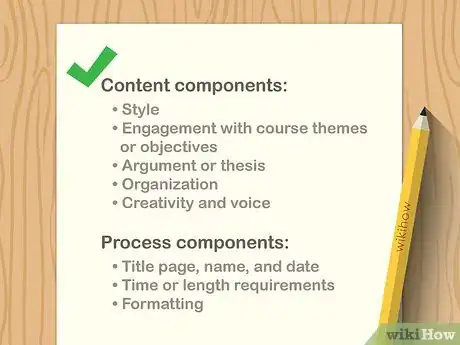
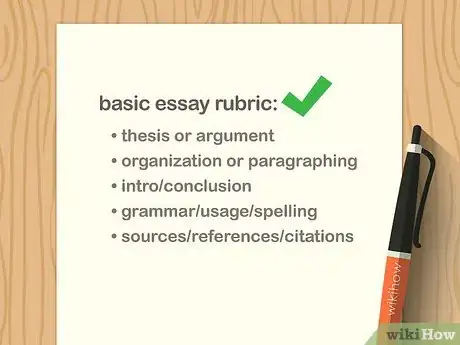
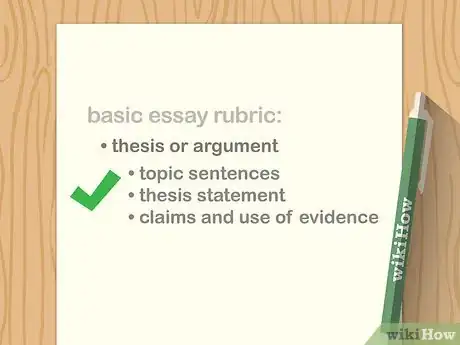
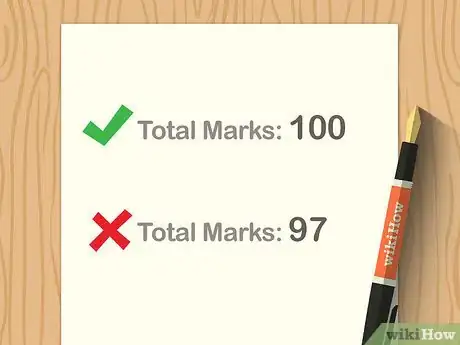



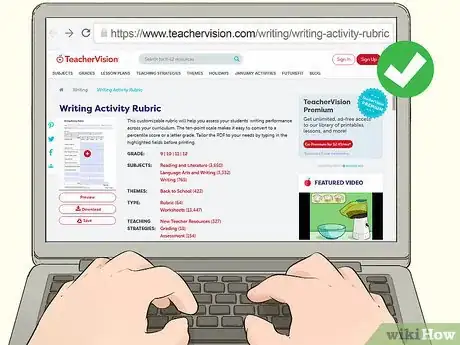




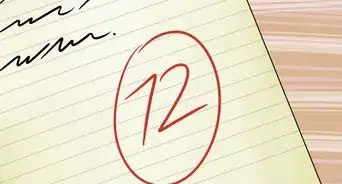











-Step-15.webp)













































